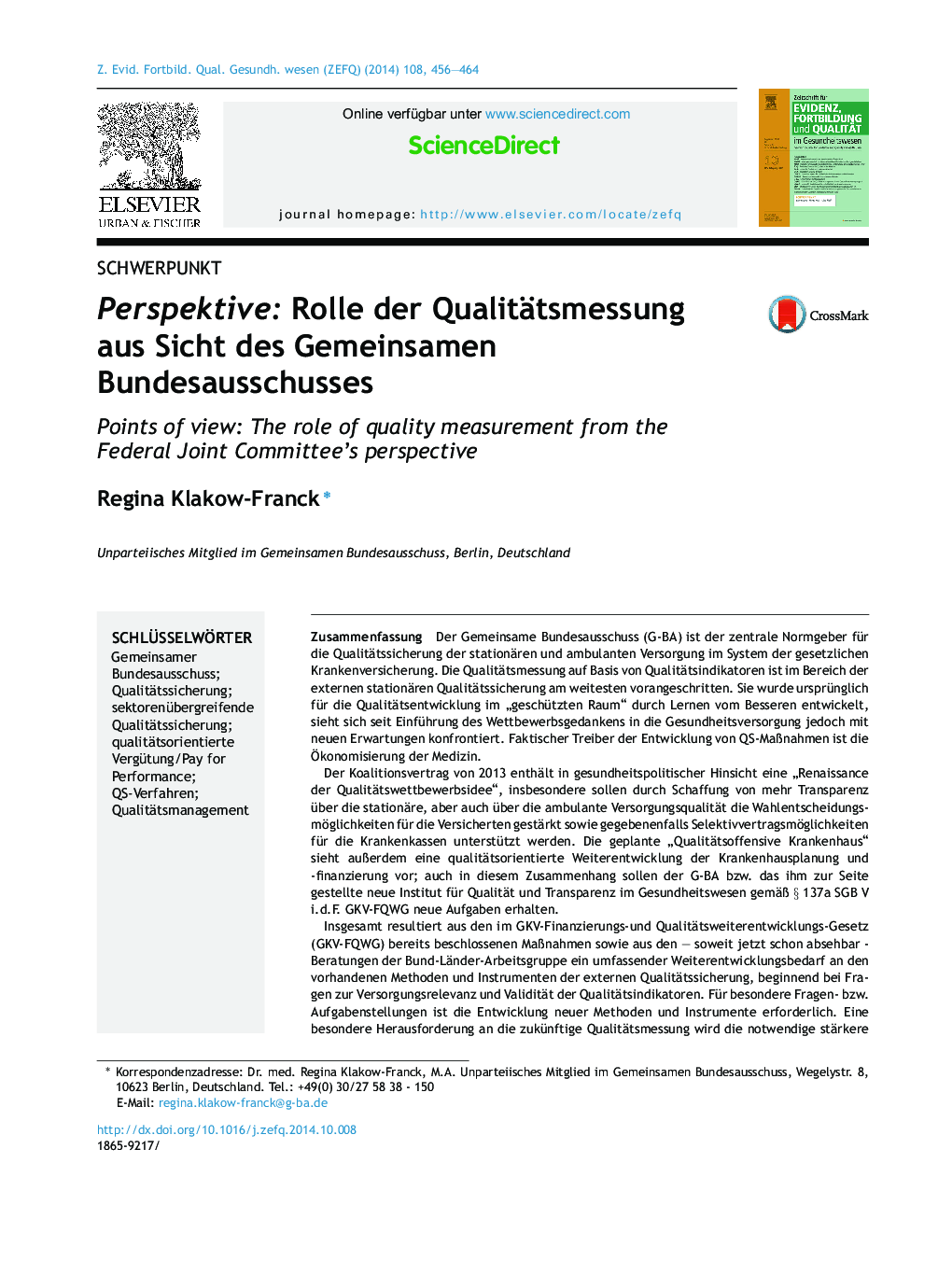| Article ID | Journal | Published Year | Pages | File Type |
|---|---|---|---|---|
| 1094107 | Zeitschrift für Evidenz, Fortbildung und Qualität im Gesundheitswesen | 2014 | 9 Pages |
ZusammenfassungDer Gemeinsame Bundesausschuss (G-BA) ist der zentrale Normgeber für die Qualitätssicherung der stationären und ambulanten Versorgung im System der gesetzlichen Krankenversicherung. Die Qualitätsmessung auf Basis von Qualitätsindikatoren ist im Bereich der externen stationären Qualitätssicherung am weitesten vorangeschritten. Sie wurde ursprünglich für die Qualitätsentwicklung im „geschützten Raum“ durch Lernen vom Besseren entwickelt, sieht sich seit Einführung des Wettbewerbsgedankens in die Gesundheitsversorgung jedoch mit neuen Erwartungen konfrontiert. Faktischer Treiber der Entwicklung von QS-Maßnahmen ist die Ökonomisierung der Medizin.Der Koalitionsvertrag von 2013 enthält in gesundheitspolitischer Hinsicht eine „Renaissance der Qualitätswettbewerbsidee“, insbesondere sollen durch Schaffung von mehr Transparenz über die stationäre, aber auch über die ambulante Versorgungsqualität die Wahlentscheidungsmöglichkeiten für die Versicherten gestärkt sowie gegebenenfalls Selektivvertragsmöglichkeiten für die Krankenkassen unterstützt werden. Die geplante „Qualitätsoffensive Krankenhaus“ sieht außerdem eine qualitätsorientierte Weiterentwicklung der Krankenhausplanung und -finanzierung vor; auch in diesem Zusammenhang sollen der G-BA bzw. das ihm zur Seite gestellte neue Institut für Qualität und Transparenz im Gesundheitswesen gemäß § 137a SGB V i.d.F. GKV-FQWG neue Aufgaben erhalten.Insgesamt resultiert aus den im GKV-Finanzierungs-und Qualitätsweiterentwicklungs-Gesetz (GKV-FQWG) bereits beschlossenen Maßnahmen sowie aus den – soweit jetzt schon absehbar - Beratungen der Bund-Länder-Arbeitsgruppe ein umfassender Weiterentwicklungsbedarf an den vorhandenen Methoden und Instrumenten der externen Qualitätssicherung, beginnend bei Fragen zur Versorgungsrelevanz und Validität der Qualitätsindikatoren. Für besondere Fragen- bzw. Aufgabenstellungen ist die Entwicklung neuer Methoden und Instrumente erforderlich. Eine besondere Herausforderung an die zukünftige Qualitätsmessung wird die notwendige stärkere Einbeziehung der Patientenperspektive sein. Patientenbefragungen sollen zusätzliche Informationen zur QS-Dokumentation der Leistungserbringer und der zukünftig bevorzugt zu nutzenden Sozialdaten-Grundlage liefern.Trotz des hohen politischen Erwartungsdrucks, was zum Beispiel die Erstellung von online-Vergleichslisten über die stationäre Versorgungsqualität anbelangt, sollte der G-BA die notwendige Einbettung von Qualitätsmessung und Public Reporting in ein umfassendes Qualitätskonzept, mit dem über eine strukturierte Rückkopplung der Ergebnisse an die Leistungserbringer eine kontinuierliche Qualitätsentwicklung gefördert wird, nicht aus den Augen verlieren. Darüber hinaus bedarf es einer konsequenten Patientenorientierung und systematischen Evaluation der QS-Maßnahmen. Durch eine stärkere Vernetzung mit der evidenzbasierten Medizin sowie mit der Versorgungsforschung könnte aus der Qualitätssicherung eine systematische Qualitätsforschung entstehen, aus der originäre Qualitäts- und Versorgungsziele ableitbar sind und die als integraler Bestandteil einer „lernenden Versorgung“ eine patientenorientierte Weiterentwicklung der Versorgungsstrukturen unterstützt.(Wie vom Gastherausgeber eingereicht)
SummaryThe Federal Joint Committee (G-BA) is a central decision-making body that issues binding directives to ensure the quality of both inpatient and outpatient health care services within the German Statutory Health Insurance system. Quality measurement on the basis of quality indicators has proceeded furthest in the field of external quality assurance (QA) of inpatient services. Originally designed for quality development in a “protected environment” through learning from better practices, it has been faced with new expectations since competitive elements have been introduced into the health care system. The economisation of medicine is de facto the driving force of the development of QA measures.In terms of health policy, the 2013 coalition agreement includes “a renaissance of the concept of quality competition“. In particular, this is meant to strengthen the decision-making options of insured persons by creating more transparency into the quality of not only inpatient but also outpatient care and, if necessary, to support the possibility of selective agreements with individual health insurance funds. The campaign planned to improve the quality of hospitals also provides for a quality-oriented advancement of hospital planning and funding; and the Federal Joint Committee, supported by the new Institute for Quality Assurance and Transparency in the Healthcare System in accordance with Section 137a of Book V of the Social Code (SGB V) in the GKV-FQWG version will be assigned new tasks within this context, too.On the whole, the measures already agreed upon in the Act to Improve the Financial Structure and Quality of the Statutory Health Insurance System (GKV-FQWG) and – as far as can now be anticipated – the proceedings of the working group set up between the German government and the German federal states indicate that there is a high need to improve the methods and tools of external quality assurance available, starting with questions about the validity of the quality indicators used and their relevance to patient care. Special issues and tasks require the development of new methods and tools. The need for paying more attention to the patient perspective will pose a particular challenge to future quality measurement. Additional information about the QA documentation of health care providers and the basis of social data that should be used preferentially can be gained from patient surveys.Despite the high political expectations (for example, concerning the development of online charts comparing the quality of inpatient care delivery), the Federal Joint Committee should not overlook the necessity of embedding quality measurement and public reporting into a comprehensive quality framework which can be used to promote continuous quality improvement through a structured feedback of the results to health care providers. In addition, we need a consistent patient orientation and a systematic evaluation of the QA measures employed. By networking more closely with evidence-based medicine and health services research, quality assurance may give rise to a systematic quality research from which genuine quality and care objectives can be derived and which, as an integral part of a “learning care”, supports a patient-oriented advancement of care structures.(As supplied by publisher)
